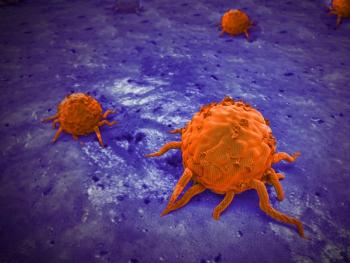
Oncology NEWS International
- Oncology NEWS International Vol 15 No 5
- Volume 15
- Issue 5
Studies Question Watchful Waiting for Some Prostate Ca Pts
The results of three studies presented at the 2006 Prostate Cancer Symposium suggest that "watchful waiting," monitoring men who have prostate cancer instead of actively treating the disease, may not be the best option for some men with low-risk disease, including older men.
SAN FRANCISCOThe results of three studies presented at the 2006 Prostate Cancer Symposium suggest that "watchful waiting," monitoring men who have prostate cancer instead of actively treating the disease, may not be the best option for some men with low-risk disease, including older men.
Using data from the Surveillance, Epidemiology and End Results (SEER) Medicare database, Yu-Ning Wong, MD, an attending physician at Fox Chase Cancer Center, and her colleagues analyzed overall survival data for 48,606 men between the ages of 65 and 80 who were diagnosed with localized prostate cancer between 1991 and 2003 (abstract 271). Only men with well or moderately differentiated tumors, stage T1-T2a or T2b-T2c, who lived for at least 365 days after the diagnosis were included in the analysis. The researchers only investigated overall mortality, not prostate-cancer-related mortality.
Men were included in the treatment group if claims were made for radical prostatectomy, hormone therapy, or radiation therapy within 6 months of diagnosis. Otherwise, men were placed in the watchful waiting group.
The median overall survival for men in the treatment group was greater than 156 months (13 years) vs 121 months (10 years) for the observation group. The men in the treatment group were more likely to be Caucasian, to be married, to belong to a higher socioeconomic group, and to have fewer comorbidities, compared with the watchful waiting group. However, Dr. Wong noted that "even when you adjust for all the differences between the groups, there still is a survival advantage to being treated."
He concluded that "this large study suggests a survival benefit to treatment in men with low- and intermediate-risk prostate cancer in the Medicare population. Elderly men should be considered for treatment with radiation or surgery."
The results of a study (abstract 37), presented by D. Andrew Loblaw, MD, MSc, assistant professor of radiation oncology, University of Toronto Sunnybrook Regional Cancer Centre, suggest that "active surveillance" with "selective delayed intervention" may be a more suitable option than watchful waiting for some men with low-risk prostate cancer.
Active surveillance involves periodic PSA testing and prostate biopsies, with treatment initiated if more aggressive disease is detected.
This prospective phase II study involved 423 men with early-stage prostate cancer (average age 71 at enrollment), most with low-risk disease. Men under age 55 were required to meet the Epstein criteria for insignificant disease. PSA was measured every 3 months for the first 2 years, then every 6 months. A repeat biopsy was performed at year 1 and then every 4 years. Radical intervention was offered for men who had a grade progression to Gleason 4 + 4 = 8 on rebiopsy, had a PSA doubling time of 2 years or less, had a doubling of their prostate nodule, or chose to discontinue watchful waiting (median follow-up, 7 years).
After 8 years, overall actuarial survival was 84% and disease-specific survival was 98.4%. Treatment was initiated in 45% of the men, 36% due to patient request, 22% due to a rapid PSA doubling time, 20% due to clinical progrssion, and 8% due to grade progression. Only four patients died of prostate cancer.
The goal of active surveillance, Dr. Loblaw said, "is to minimize side effects while protecting patients from prostate cancer," by avoiding treatment when possible while carefully following patients for disease progression. "This study has shown that over a 10-year period, virtually all men with favorable-risk prostate cancer managed with active surveillance will die of unrelated causes," he noted.
The value of measuring PSA levels during watchful waiting was also supported by the results of the third study (abstract 3), presented by Jennifer Cullen, PhD, MPH, assistant professor of surgery at the Uniformed Services University of the Health Sciences and a research epidemiologist at the Center for Prostate Disease Research (CPDR).
This retrospective review analyzed the clinical records of 1,369 men (mean age, 68.7 years), diagnosed with cT1-cT2 prostate cancer between 1989 and 2003, and whose initial treatment was "watchful waiting" without secondary intervention. Due to missing data, only 871 men were included in the multivariate analysis. High PSA velocity (PSAV) was defined as a rise of greater than 2 ng/mL/yr.
With a mean follow-up time of 54.7 months, 56% of the men in the high-PSAV group were still alive, compared with 87% in the low-PSAV group.
"PSA velocity significantly predicts the odds of overall death in military health care beneficiaries diagnosed with clinically localized prostate cancer who are followed with watchful waiting without secondary treatment," Dr. Cullen concluded. However, she added that additional research is needed to replicate these findings in nonmilitary populations and to determine the optimal frequency and timing of PSA testing.
Articles in this issue
over 19 years ago
Genentech Files sBLA for Avastin for First-Line NSCLC Treatmentover 19 years ago
RFA Effective for Single, Small Hepatocellular Carcinomaover 19 years ago
New Imaging, ChemoRT Recommendations From NCCNover 19 years ago
Panitumumab Improves PFS in Advanced Colon Caover 19 years ago
Growing Evidence Supports Stem Cell Hypothesis of Cancerover 19 years ago
FDA Approves New Every-3-Week Dosing for Aranespover 19 years ago
Telephone Often Delivers News of Breast Cancer Diagnosisover 19 years ago
IND Submitted for CYT-500Newsletter
Stay up to date on recent advances in the multidisciplinary approach to cancer.


















































































